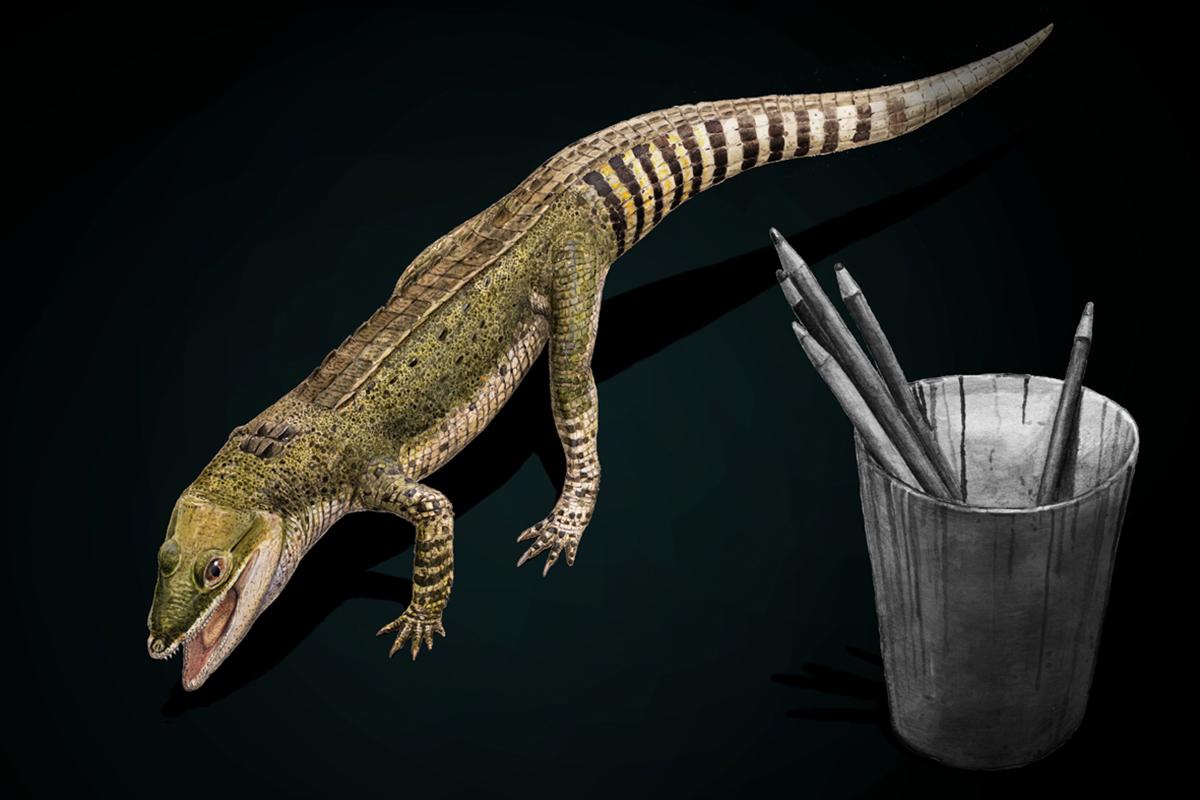Researchers from the Museum fuer Naturkunde Berlin and the Landesmuseum Hannover have described a new genus and species of a small atoposaurid crocodile. The extinct group of atoposaurids is among the ancestors of modern crocodiles. Knoetschkesuchus, the newly described crocodile genus, lived together with small sized dinosaurs on an island in the Jurassic sea and was closely related to another Jurassic crocodile from Portugal.
Knoetschkesuchus langenbergensis was a small-size crocodile that did not exceed 50 cm in body length. The tiny crocodile with short snout and large eyes would certainly have been a favorite in the terrarium of lovers of reptiles, however, it lived already 154 millions of years ago in northwestern Germany. The specimens described by the authors had been found in a limestone quarry near Goslar, which is known for a variety of marine and terrestrial fossils such as the small sized dinosaur Europasaurus holgeri. Knoetschkesuchus is represented by two exceptionally well-preserved skulls and some other skeletal remains of different ontogenetic ages. The fossil skulls are partly embedded in sediment and only a few centimeters long, which made their exact taxonomic determination difficult. They were initially determined to belong to Theriosuchus, a genus of atoposaurid crocodiles that was widespread in the late Jurassic of Europe. “The skull remains are superficially very similar to Theriosuchus and the few differences visible were explained by ontogenetic variation. It was by then just consequent to assign them to Theriosuchus”, explains D. Schwarz.
With the help of micro-CT images, the small skull remains could now be examined to the last detail and also from the interior of the slab, allowing precise new skull reconstructions. These reconstructions revealed an interesting new combination of characters: The Jurassic crocodile from the Langenberg possesses two different morphotypes of teeth, comprising both acute conical teeth in the front and more rounded lanceolate teeth in the back of the jaws. Also characteristic are the choanae, bony openings of the nasal canal into the throat, an additional opening in front of the eyes and in the lower jaw, and special proportions of the temples and skull roof. A similar combination of characters is also visible in a small crocodile from the late Jurassic of Portugal, which was described as Theriosuchus guimarotae, making it necessary to find a new genus name for both crocodiles. The authors chose the name Knoetschkesuchus in honor of Nils Knötschke, the longtime preparator and coordinator of the fossil finds at the Dinosaurier-Park Münchehagen, whose dedication to the paleontological work was crucial for the recovery and conservation of the specimens. By naming this new genus of crocodiles, it could be demonstrated that the variety of fossil crocodiles in the Late Jurassic of Europe was larger than hitherto known. Similar to Theriosuchus, Knoetschkesuchus belongs to the group of Atoposauridae, which comprises small sized crocodiles with large eyes and short snouts from the Jurassic and Cretaceous. Phylogenetically, atoposaurid crocodiles were close to the origin of modern crocodiles, which is also corroborated by this study. Whereas Knoetschkesuchus probably relied mostly on insects for its diet, Theriosuchus developed a third tooth morphotype, comprising more compressed and jagged teeth that helped this taxon to include also herbivorous or frugivorous food items. The finds of Knoetschkesuchus therefore also reveal that an important factor for the evolution of atoposaurids was the diversification of tooth morphotypes and dietary preferences. Knoetschkesuchus lived probably along swampy parts of small islands in the Jurassic archipelago and was present in single environments with different species. According to O. Wings: “This quarry represents a unique insular fauna from the Late Jurassic with a diverse fauna of terrestrial and aquatic organisms. Knoetschkesuchus fits perfectly into this environment and helps us to understand better the faunal composition of small fossil islands”. The study is part of the “Europasaurus-Project”, which has been coordinated by the Landesmuseum Hannover since 2012. It is supported by the Volkswagen Foundation.
Published in: Schwarz, D., Raddatz, M. & Wings, O. 2017. Knoetschkesuchus langenbergensis gen. nov. sp. nov., a new atoposaurid crocodyliform from the Upper Jurassic Langenberg Quarry (Lower Saxony, northwestern Germany), and its relationships to Theriosuchus. PLoS One. http://journals.plos.org/plosone/article?id=10.1371/journal.pone.0160617
Images you can get here:
http://download.naturkundemuseum-berlin.de/presse/Zwergkrokodil
- Drawing of Knoetschkesuchus langenbergensis. Artist: Joshua Knüppe
- Specimens of Knoetschkesuchus langenbergensis in their natural environment in Northwestern Germany, on display with a cadaver of the contemporaneous dwarfed sauropod dinosaur Europasaurus holgeri. Artist: Joshua Knüppe
- Limestone slab containing the partial skeleton of Knoetschkesuchus
